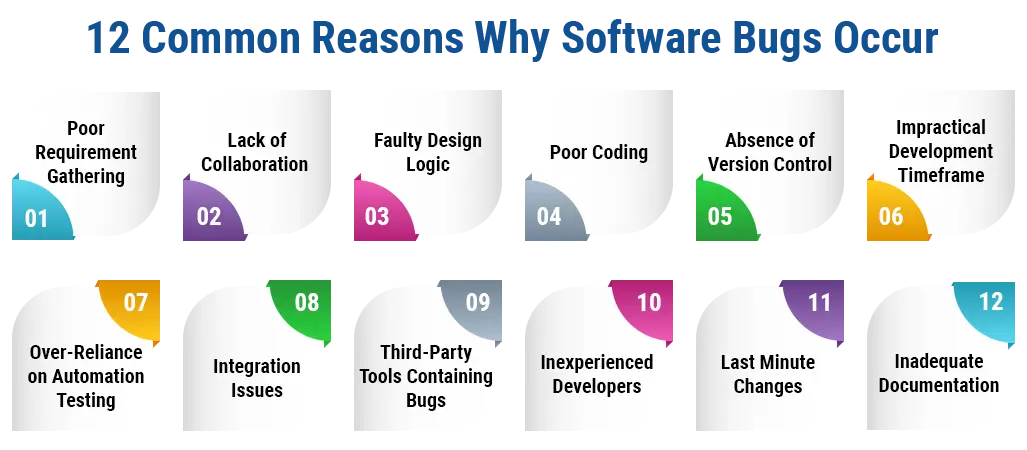
Users may find software defects annoying, and businesses may find them expensive. Engineers and project stakeholders need to comprehend the shared causes of these issues. We'll explore 12 common causes of bugs in software in this blog, illuminating variables that may affect the dependability of development programs. Incorporating System Testing Services into the development cycle can help identify these issues early on. We can prevent their consequences and improve the general caliber of software products by proactively recognizing these reasons.
Table of Contents
- What are Software Defects?
- 12 Common Reasons Why Software Bugs Occur
- Poor Requirement Gathering
- Lack of Collaboration
- Faulty Design Logic
- Poor Coding
- Absence of Version Control
- Impractical Development Timeframe
- Over-Reliance on Automation Testing
- Integration Issues
- Third-Party Tools Containing Bugs
- Inexperienced Developers
- Last Minute Changes
- Inadequate Documentation
- On a Closing Note,
- People Also Ask
What are Software Defects?
Software defects, usually referred to as bugs or issues, are abnormalities or defects found in software applications, causing unexpected behavior or functioning otherwise. There can be many reasons, such as coding mistakes, bad design, wrong requirements interpretation, or lack of proper testing. Functional defects mainly cause the non-working of an application with increased response times and excessive resource consumption, while usability bugs hinder the user's interaction with the application. This can impair user experience are some of the ways they can appear.
Software faults must be identified and corrected as early as possible in order to guarantee the reliability, quality, and utility of software products. Defects can be categorized on a scale of severity and impact-from minor annoyances that hardly affect functioning to catastrophic defects that can bring failure of the system. This, in turn means that the entire process of defect management entails proactive debugging methods, rigorous bug testing of the software throughout the development process, and continuous defect evolution based on feedback and observation in the production scenario. Quickly fixing errors or software bugs testing contributes to providing end users with reliable and stable software solutions.
12 Common Reasons Why Software Bugs Occur
To increase the quality and dependability of software, developers and teams must comprehend the primary causes of defects. Here are 12 common causes of software project failure that you need to know:

Poor Requirement Gathering
There is a greater possibility of misalignment between what developers deliver and what stakeholders want when requirements are not captured efficiently. This may result in incorrect features, inadequate functionalities, or misguided user requirements. Because of this, developers implement things poorly or forget important details, which might lead to software defects. As a result, efficient requirement gathering is crucial to building a strong base for software development, lowering the chance of introducing errors, and guaranteeing that the final product effectively satisfies the needs of stakeholders.
Lack of Collaboration
A variety of misunderstandings and miscommunications may arise at various stages of the project between various stakeholders such as project managers, developers, and testers. These misunderstandings arise due to various reasons such as unclear or changing requirements, lack of feedback loops, and the absence of documents. This frequently leads to development efforts falling short of the desired outcomes, which causes flaws to appear in the product during testing or deployment.
Faulty Design Logic
Logical inconsistencies may be introduced into the program architecture by flawed design choices. This could be utilizing improper design patterns, not considering edge circumstances, or ignoring crucial system interactions. These sorts of design errors might emerge as subtle problems in the course of development, which are difficult to discover and fix. Once development is in full swing, it is very difficult and costly to correct these design defects, thereby proving a point about the need for an elaborate design evaluation and validation process at the beginning.
Poor Coding
Use of poor writing technique, such as inconsistent coding standards, ineffective algorithms, or bad error-handling methods, introduces bugs in the code. Software failure may result from typical coding errors, such as race conditions, memory leaks, or off-by-one-find faults, which lead to an unexpected runtime behavior.
Absence of Version Control
In the absence of version control systems such as Git, code change management becomes difficult. The act of developers overwriting one another's work might result in lost code history and integration problems. Due to poorly managed or tested changes that are conflicting or incomplete, this may lead to issues. To increase software quality, teams can also employ preventive measures and continuous improvement initiatives with the aid of defect metrics and analysis, which offer insights into reoccurring issues.
Impractical Development Timeframe
Developers may have to speed through the coding and testing stages to meet unrealistic schedules, compromising quality in the process. In these circumstances, comprehensive testing and review procedures are sometimes shortened or omitted, which raises the possibility of introducing flaws that are not discovered until much later in the development or deployment process.
Over-Reliance on Automation Testing
Even while automated testing works well for repetitive chores, there are some situations when manual testing is still necessary. Strict use cases, problems with the user experience, or environmental variances that are better discovered through human-driven testing may be overlooked if automated testing is the only method used. Undiscovered bugs may find their way into production because of this over-reliance. To reduce the possibility of undetected problems in production and guarantee thorough testing coverage, it may be beneficial to combine automated and manual testing techniques. Hire automation testing services, which integrate the best features of both approaches to produce software that is dependable and strong, for customized and effective testing solutions.
Integration Issues
Data inconsistencies, communication issues, and compatibility issues might arise when integrating several systems or components. These integration problems frequently result in errors that are hard to anticipate and fix during development since they only show up when various components of the system interact.
Third-Party Tools Containing Bugs
Software that uses third-party libraries, APIs, or tools may be vulnerable to flaws found in those dependencies. These issues may spread into the primary program and result in unforeseen activities or vulnerabilities that show up as software bugs if they are not found or fixed. For fault prevention and early identification, quality assurance procedures and ongoing testing are essential. By proactively addressing potential issues, the possibility of having problems slip into production environments is reduced, thus improving software reliability and enhancing customer satisfaction. In other words, regular monitoring and updates of dependencies are essential to ensure their compatibility with the latest versions and patches and to minimize the risk of the injection of defects from external sources.
Inexperienced Developers
For beginners in development, it is courses or mentoring programs that would develop their capabilities and help them understand software engineering principles more deeply. New entrants risk introducing many faults due to inexperience or lack of competence, which would otherwise be reduced by investing time in continual learning and knowledge sharing within teams. Over time, this proactive approach lowers defect rates and raises software quality by fostering a culture of skill development and continuous improvement.
Last Minute Changes
Testing procedures and established workflows may be disrupted by introducing late changes into the development process. Late changes are often made in haste, bypassing normal levels of review or testing; thus, new bugs or regression issues may be introduced that were not catered to in the original design and testing strategy. Therefore, conducting testing early and often becomes very important in diminishing the negative impact of late changes on software quality and stability, accompanied by well-defined change management processes. By being proactive, defects of this nature could be detected and fixed before they can escalate and create serious problems further down the development or deployment line.
Inadequate Documentation
When they are not very good or have become old, documentation can cause engineers to find it harder to understand or modify the software. Without suitable system design documentation, API specifications, or procedural guidelines, developers may misinterpret requirements or make assumptions. Such misunderstandings could result in faulty software or flawed implementation. Hence, for developers, good documentation represents a very useful resource to aid in debugging, maintaining, and improving the functionality of the software in the future. Updating documentation may take up some time, but it guarantees streamlined coordination and significantly reduces the chances of error due to wrong assumptions or incompleteness of information.
On a Closing Note,
Software faults may result from a number of limitations, such as difficult requirements, inadequate testing, coding errors, and poor documentation. Software development teams can efficiently prevent cracks or find and fix errors in every software development lifecycle. Quality assurance must be made a priority, invest up to the maximum in rigorous testing, and encourage communication to minimize the damage of software defects- it creates increasingly viable applications for users. In the end, awareness of these causes will enable teams to build software that meets strict standards for usability, performance, and usefulness.
For complete software quality assurance and efficient defect management, reach a recognized software testing company. They provide client-specific solutions to the usual cause of software faults to ensure that applications are robustly reliable and easy to use for the stringent requirements of usability, performance, and function.
People Also Ask
1. What are software bugs, and why do they occur?
Software bugs are defects or mistakes that cause a program to behave abnormally or differently from its intended behavior. They can be caused by various factors, such as ambiguous development specifications, inadequate testing, coding faults, and intricate requirements.
2. How do coding errors contribute to software bugs?
Software bugs may be induced by errors in code, such as improper edge case handling, logical errors, and syntax errors. Once the code is run, the errors may result in crashes, improper behavior, or functionality issues.
3. How do your testing services contribute to the overall software development lifecycle?
Our testing services provide ongoing verification and feedback at every stage of the software development life cycle, fitting seamlessly into the workflow. We help minimize risks, optimize resources, and produce high-quality software solutions on time and within budget by catching and correcting problems in the early stages.
4. How do you approach resolving bugs discovered during testing?
To fix defects in a systematic way, we first prioritize them based on their severity and impact. To ensure the issue is fully resolved, our team identifies the root cause, develops a targeted solution plan, implements fixes, and performs regression tests.
5. What measures do you take to prevent recurring bugs in future releases?
We perform rigorous root cause analysis of software defects to determine problems and avoid repeated bugs. To minimize similar mistakes in future releases, we implement remedial actions, enhance test coverage, update documentation, and incorporate lessons learned into our development and testing activities.
6. How do you prioritize bug resolution alongside new feature development in agile projects?
We employ agile methodologies, which put high emphasis on flexibility and rapid decision-making. In order to balance problem-solving activities with developing new features, our teams collectively review bug severity, impact, and user feedback to ensure balanced project delivery.

